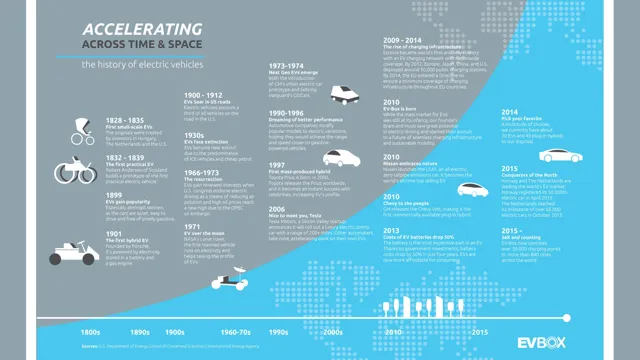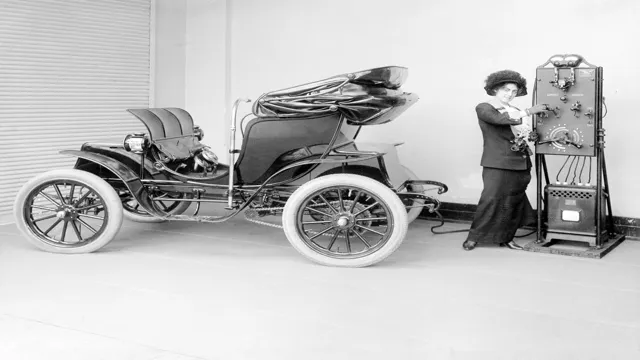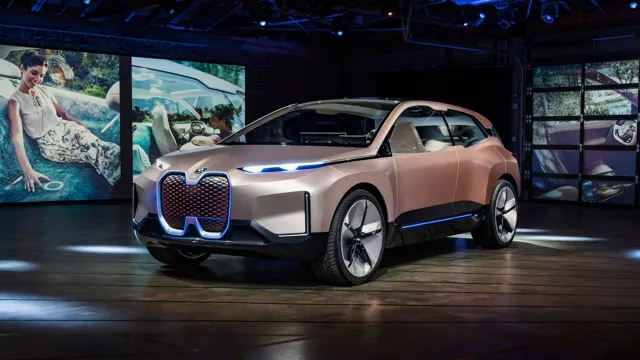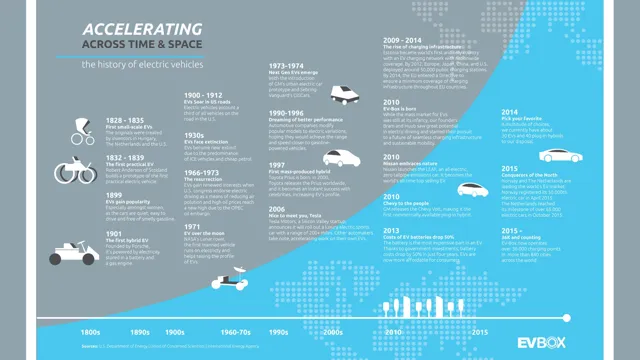The Shocking Evolution: Uncovering the Fascinating History of Electric Car Batteries
Have you ever wondered about the history of electric car batteries? How did we go from basic lead-acid batteries to today’s advanced lithium-ion batteries? Electric cars are becoming mainstream, and with it, the technology that powers them. The development of electric vehicles has been a fascinating journey that dates back to more than a century ago. In this blog post, we will dive into the history of electric car batteries and trace the key milestones that have brought us to where we are today.
Join us as we explore the past, present, and future of electric car batteries.
Early Development
The history of electric car batteries dates back to the early 19th century when scientists first started experimenting with electric vehicles. Battery technology at the time was still in its nascent stages, and the available batteries were heavy, inefficient, and had a limited range. The first practical rechargeable batteries were developed in the late 1800s, but it wasn’t until the early 1900s that they were used in electric cars.
The first electric cars were popular with early adopters, but their high cost and limitations in range made them impractical for the average person. It wasn’t until the 1990s that electric cars started gaining traction again, with advancements in battery technology leading to increased range and efficiency. Today, electric cars are becoming more commonplace as battery technology continues to improve and become more affordable.
The history of electric car batteries shows that while the technology has come a long way, there is still much room for improvement and innovation.
Lead-acid batteries in EVs in early 1900s
Lead-acid batteries were the go-to choice for early electric vehicles in the 1900s. These batteries were initially developed in the mid-1800s for stationary power applications, but it wasn’t until the rise of electric vehicles that they became widely used. Despite their weight and limited range compared to gasoline engines, lead-acid batteries were still more favorable due to their reliability and ease of maintenance.
They had a simple design and were readily available and affordable, making them an attractive option for early EV manufacturers. However, as technology progressed and the demand for longer-range EVs increased, lead-acid batteries were eventually replaced with more advanced battery technologies, such as lithium-ion and nickel-metal hydride batteries. Despite their decrease in popularity, lead-acid batteries still remain in use today for auxiliary power in electric vehicles.
Nickel-iron batteries invented by Edison in 1903
Nickel-iron batteries, Edison, early development In 1903, Thomas Edison invented a battery that made use of nickel and iron. This type of battery, which is now commonly known as the nickel-iron battery, had several benefits over the lead-acid batteries that were commonly used at the time. For one, nickel-iron batteries were more durable and had longer lifespans, making them ideal for use in electric vehicles.
They were also less prone to damage from high temperatures and overcharging, which further increased their reliability. Despite these advantages, nickel-iron batteries never gained widespread popularity due to their heavy weight and high cost. Nevertheless, the invention of this battery by Edison marked an important step forward in the development of batteries and helped pave the way for future advancements in the field.
Problems with early batteries – heavy and short range
Early batteries faced significant challenges when it came to weight and range. The first batteries were often large and heavy, making them impractical for everyday use. Additionally, their range was limited and would quickly run out, creating further issues for their users.
These early batteries were typically developed for specific purposes, such as powering telegraph transmissions or early mining operations, rather than for broader use. It wasn’t until advancements in technology and the discovery of new materials that batteries became smaller, lighter, and more efficient. Today, we can carry batteries in our pockets that can power our devices for hours, if not days.
The early struggles of battery development remind us of how far we’ve come and how much more innovation is yet to come.
Modern Developments
The history of electric car battery has witnessed some significant developments in recent years. One crucial innovation is the introduction of lithium-ion batteries, which have been widely used in electric vehicles (EVs) and hybrid electric vehicles (HEVs). These batteries are highly efficient, have a longer lifespan than traditional lead-acid batteries, and are lightweight.
Another development in the industry is the rise of solid-state batteries, which offer a higher energy density and make EVs cheaper and more practical. Manufacturers are also working on developing fast-charging systems that would allow drivers to charge their batteries in just a few minutes. As the demand for EVs increases, the advancements in battery technology will play a crucial role in driving the future evolution of this market.
Introduction of Li-ion batteries in 1990s
The introduction of Li-ion batteries in the 1990s was a game changer for the world of electronics. These batteries have become the preferred choice for powering a wide array of portable devices, including smartphones, laptops, and electric vehicles. Over the years, Li-ion batteries have undergone several modern developments to improve their efficiency, safety, and durability.
One of the most significant advancements in recent years has been the use of silicon-based anodes, which offer higher energy density than traditional graphite anodes. Other innovations include the development of solid-state batteries, which use a solid electrolyte instead of a liquid one, making them safer to use and potentially increasing their lifespan. As technology continues to advance, we can only expect further developments and improvements to Li-ion batteries, paving the way for a more sustainable, energy-efficient, and connected future.
Tesla’s use of cylindrical Li-ion battery in 2008
Tesla’s use of cylindrical Li-ion battery in 2008 marked a major turning point in the automotive industry. This move revolutionized the way we look at electric cars and their potential for long-range driving. Tesla’s innovative use of cylindrical Li-ion batteries allowed them to pack more energy into a smaller space.
This resulted in a longer driving range, faster charging times, and better overall efficiency. Not only did this bring electric cars closer to matching the performance of gasoline-powered cars, but it also helped to make them more practical for everyday use. This technology has continued to evolve over the years, with new developments that have made electric cars even more powerful and reliable.
Today, electric cars have become a viable alternative to traditional cars, and Tesla has been a major driving force behind this shift towards more sustainable transportation. Tesla’s use of cylindrical Li-ion batteries is a true testament to the power of innovation and how it can change the course of an entire industry.
Improvements in energy density and range
Electric vehicles have come a long way over the years, with modern developments focusing on improving energy density and range. In the early days of EVs, the range was often limited to just a few miles, which made them impractical for anything other than short trips. Nowadays, however, we’re seeing major improvements in both the energy density of EV batteries and the overall range they can achieve.
This is thanks in part to advances in battery technology, which has allowed manufacturers to cram more energy into smaller packages. Additionally, many EVs now come with larger battery packs, which can provide extended ranges of up to 300 miles or more on a single charge. With these advancements, electric vehicles are becoming increasingly viable options for both long-distance travel and everyday commuting.
Continued research and development for better performance
One of the most exciting aspects of modern technology is the constant push for continued research and development. This is especially true when it comes to improving performance. Whether it’s better graphics on our phones or more efficient batteries for electric cars, there seems to be no end to the innovation we can expect to see in the coming years.
One of the areas where we’re likely to see some of the most significant modern developments is in the world of artificial intelligence (AI). With machine learning algorithms becoming more sophisticated every day, we’re starting to see real-world applications that were once thought impossible. For example, AI is now being used to help diagnose diseases and develop new drugs, and it’s also helping to improve productivity and efficiency in a wide range of industries.
Another exciting area of modern development is in the world of renewable energy. As we continue to grapple with the challenges of climate change, there’s been a renewed focus on finding sustainable sources of power. From wind and solar to geothermal and hydroelectric, researchers are constantly pushing the boundaries of what’s possible, and we’re seeing some remarkable breakthroughs as a result.
Ultimately, modern developments are all about finding new and better ways to solve problems. Whether it’s improving the performance of our devices, creating new technologies that can revolutionize industries, or finding sustainable solutions to the world’s most pressing challenges, there’s always something exciting happening on the cutting edge of research and development. As long as we continue to invest in innovation, there’s no telling what we might achieve in the years to come.
Future Outlook
Looking into the history of electric car batteries, it’s clear that there have been many advancements over the years. From the first crude battery-powered cars in the 19th century to the modern-day electric vehicles that have become increasingly popular, there have been many developments in battery technology. Lithium-ion batteries are currently the most common type used in electric vehicles.
However, there is still room for improvement in terms of increasing their range and reducing their cost. Some companies are exploring the use of solid-state batteries, which are more energy-dense and have the potential to be cheaper to produce. Additionally, advancements in charging infrastructure are making it easier for drivers to charge their EVs on the go.
Overall, the future outlook for electric vehicles is promising as battery technology continues to improve and charging infrastructure expands.
Push for more sustainable and eco-friendly battery materials
As the world contemplates the adverse effects of the non-renewable energy sources, there is an increasing push for more sustainable and eco-friendly battery materials. The race for more efficient and reliable battery technology has propelled innovation in the battery manufacturing industry. Researchers and manufacturers are exploring new materials that would reduce the ecological footprint of battery production and usage.
The future of battery technology is going green, with more focus on developing sustainable batteries that can perform efficiently while reducing their environmental impact. Lithium, cobalt, and nickel are some of the most commonly used materials in battery production. However, these materials have come under scrutiny for environmental concerns, particularly when it comes to mining and disposal.
The push for eco-friendly battery materials is aimed at reducing the environmental impact of mining activities and toxic waste disposal. The new generation of batteries is likely to be made from organic, abundant, and recyclable materials that would reduce the pressure on the environment and aid in the move towards a sustainable future.
Advancements in solid-state battery technology
Solid-state battery technology is rapidly advancing and could be a game-changer in the energy industry. With greater capacity and longer life than traditional lithium-ion batteries, solid-state batteries offer a promising solution for energy storage needs. The future outlook for this technology is optimistic, as many companies are investing heavily in its development and commercialization.
As this technology improves, it could have a significant impact on the electric vehicle and renewable energy industries. With solid-state batteries, electric vehicles could have a longer range and faster charging times, while renewable energy systems could store more energy for longer periods. This technology also has the potential to reduce the risk of fires caused by traditional lithium-ion batteries.
Overall, the future looks bright for solid-state battery technology, and its continued development could revolutionize the way we store and use energy.
Potential for wireless charging technology
Wireless charging technology has the potential to revolutionize how we power our devices in the future. With the growing demand for more convenient and efficient charging methods, the outlook for wireless charging is bright. As the technology continues to advance, we can expect to see more devices incorporating wireless charging capabilities, making it easier than ever to keep our gadgets powered up without the need for cords or batteries.
With the added benefit of being more environmentally friendly, wireless charging technology is poised to become a game-changer in the tech industry. Imagine being able to charge your phone, laptop, or smartwatch by simply placing them on a surface, without worrying about tangled cords or outlet availability. This is the future that wireless charging technology promises, and it’s an exciting one.
As companies continue to invest in research and development, it’s only a matter of time before we see widespread adoption of this new technology.
Increased adoption of EVs driving battery innovation
The increased adoption of electric vehicles (EVs) is driving battery innovation like never before. As more companies invest in EVs and consumers choose them over traditional gasoline-powered vehicles, the demand for better and more efficient batteries has skyrocketed. This trend is pushing companies to invest heavily in research and development, and we’re seeing some exciting advancements in battery technology as a result.
For example, some batteries now have longer range and can charge more quickly, making EVs more practical for everyday use. In addition, there’s been a lot of focus on making batteries safer and more sustainable, which will be essential as EVs become even more widespread. Overall, the future of battery technology is looking bright, and we can expect to see a lot more exciting innovations in the near future.
As the world moves towards a more sustainable future, the EV industry will play a crucial role, and battery companies will need to keep up with demand to ensure that EVs remain a viable alternative to traditional vehicles.
Conclusion
In conclusion, the history of the electric car battery is one filled with innovation, challenges, and opportunities. From humble beginnings with lead-acid batteries to the exciting potential of lithium-ion technology, the evolution of electric car batteries has been a continuous journey towards creating a sustainable transport solution. While the road towards electric mobility may have been bumpy, a bright future lies ahead fueled by the collective determination of scientists, engineers, and everyday people who hold the power to shape our world for the better.
It’s electrifying how far we’ve come, and even more exhilarating to imagine what’s still to come!”
FAQs
What is the history behind the development of electric car batteries?
The development of electric car batteries began in the mid-19th century with the invention of lead acid batteries. Since then, there have been several advancements in batteries, including the introduction of nickel-cadmium and lithium-ion batteries.
How have electric car batteries evolved over time?
Electric car batteries have evolved significantly over time, from early lead-acid batteries with limited range to modern lithium-ion batteries with longer ranges and faster charging times.
What are the benefits of using electric car batteries?
Electric car batteries offer several benefits over traditional fossil fuel-powered vehicles, including lower emissions, reduced dependence on oil, and potential cost savings over the long term.
How do electric car batteries compare to gasoline-powered car batteries?
Electric car batteries differ significantly from gasoline-powered car batteries in terms of their composition and charging requirements. Electric car batteries are typically larger and heavier than gasoline-powered car batteries and require specialized charging infrastructure.






